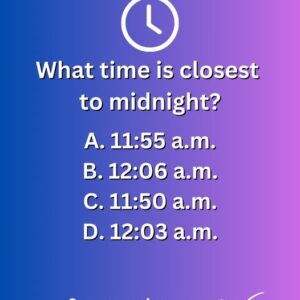what started as a childish-looking math question on a popular social network has grown into an international viral one sensation, with intense debates online. This question, initially posted on Reddit, simply asked for “the time closest to midnight.” However, it soon became apparent that behind this apparent simplicity lay a complex problem. Thousands comments flooded in in a sign of massive engagement, with users putting both their math skills and critical thinking on display.
In June 2023, @yawdmontweet, a Reddit user living in Jamaica, launched a question that not only surprised but also invited deep deliberation.
The question was, “What is the time closest to midnight?”
The options were: A. 11:55, B. 12:06, C. 11:50, D. 12:03.
The apparent directness of the question paved the way for an explosion of public interest, which made the post go viral in an instant.
Within a short time, this puzzle was the topic of discussion in various forums, classrooms and even in casual conversations, as people tried to unravel the complexity behind these simple time markers.
Discussie
The core of the extensive online discussion revolved around what exactly was meant by ‘closest to midnight’.
Although a large majority of participants supported option D (12:03), the subtlety of the question resulted in a considerably broader spectrum of responses.
Contrary to what one would expect from a math question, this involved not only calculating time intervals, but also semantic interpretations of the question itself.
This illustrates how language and context can play a fundamental role in our perception and approach to seemingly simple things problems.
Interpretations
The math puzzle illustrated the richness of human interpretation when confronted with a seemingly obvious question.
Some users interpreted the question in terms of the time physically closest to midnight, which led them to times shortly after noon.
Others, however, approached the question from a more abstract perspective, discussing concepts such as ‘the run-up to midnight’ and even philosophical questions of time and space.
These diverse approaches revealed a fundamental question: How does our perception of words and context influence our understanding of a problem?
Intelligence
Artificial intelligence played an important and sometimes controversial role in the discussion.
Tools such as ChatGPT were consulted to provide a scientific look at the puzzle.
ChatGPT, for example, concluded that “the time closest to midnight is D. 12:03 a.m.,” which some participants saw as definitive, while others argued that an AI’s interpretation may have been too narrow for a question that was also a requires human, more flexible consideration of context.
Implications
The extensive debate about this mathematical puzzle revealed an important pedagogical concern.
The possibility that a seemingly direct question can yield multiple valid answers depending on interpretation suggests a need for clarity in the formulation of educational materials.
This is crucial, especially in education, where confusion occurs among young pupils can cause not only frustration, but also a lasting aversion to subjects such as mathematics.
Conclusion
This viral math puzzle shows how a question at the intersection of language and logic can become a global discussion point.
It provides insight into the complexity of human cognition and the way different people interpret information and approach problems.
It reminds us that even the simplest questions can lead to profound intellectual challenges and… cultural connections.



